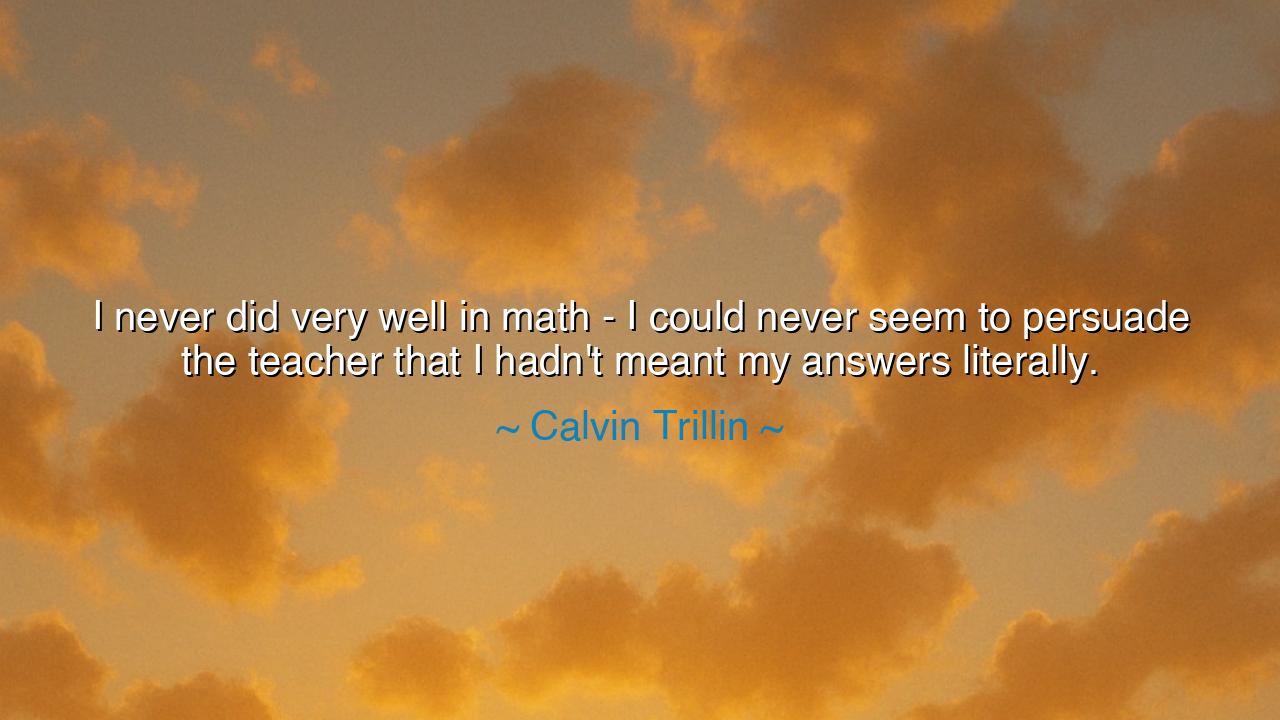
I never did very well in math - I could never seem to persuade
I never did very well in math - I could never seem to persuade the teacher that I hadn't meant my answers literally.






"I never did very well in math — I could never seem to persuade the teacher that I hadn’t meant my answers literally." Thus spoke Calvin Trillin, the humorist and observer of human nature, whose wit hides beneath it a deep and timeless wisdom. In this line, which at first appears as mere jest, lies a reflection on the eternal dance between imagination and logic, between the creative spirit and the rigid order of systems made by men. The student of numbers fails not because he lacks intelligence, but because he dares to see the world not as formula, but as poetry. His “answers,” though wrong by the book, are right in spirit—born of curiosity, wonder, and the refusal to be bound by literal thinking.
Trillin’s humor masks a truth that the ancients knew well: that there are many kinds of understanding. The mathematician seeks precision; the poet seeks meaning. Yet both, in their highest form, touch the same divine mystery. When Trillin says he “could not persuade the teacher,” he speaks of a struggle that has existed since time began—the struggle between those who see the world as it is and those who see it as it might be. The literal mind demands obedience to rules; the imaginative mind seeks freedom beyond them. The true wisdom of this quote lies in recognizing that both are necessary—but it is the imaginative one that gives life its beauty, its color, and its spark.
In the great ages past, even the wisest knew that imagination gives birth to reason, not the other way around. Leonardo da Vinci, the painter, the scientist, and the dreamer, was mocked by his peers for his strange machines and endless sketches. Many of his ideas could not be proven by the math of his time, and yet, centuries later, we found his visions to be true. His answers, too, would have seemed “wrong” to his teachers, for he answered the world’s questions not in numbers, but in images. He imagined beyond the literal, and in that daring, he became immortal.
Trillin’s reflection, though humorous, carries a lament for a world that too often punishes the dreamer. The child who sees the moon as a lantern of the gods is told to remember that it is only rock and dust; the student who paints numbers with color and metaphor is told to “focus.” Yet without such dreamers, we would have no poets, no inventors, no philosophers. The literal mind builds walls; the imaginative mind builds worlds. It is the latter that keeps the soul of humanity alive. Trillin’s “failure” in math is, in truth, the triumph of a spirit unwilling to let truth become dull.
And yet, we must also see in his words the delicate balance of human understanding. Numbers, too, are a kind of poetry—an invisible music that orders the stars and defines the rhythm of the universe. The teacher, bound by the rule of correctness, represents discipline, the framework upon which creativity must stand. The student, lost in imagination, represents the breath of life that animates all structure. Without imagination, rules are dead; without structure, imagination dissolves. The harmony of these two is the mark of true genius.
Consider Albert Einstein, who once said that imagination is more important than knowledge. He, too, began as a student misunderstood. His teachers thought him lazy, unfocused, unpromising. Yet within him stirred an idea—one that no equation had yet captured—that time itself could bend and stretch like a fabric. Through imagination, he saw what the literal mind could not: that truth is not confined to numbers, but revealed through wonder. In him, the poet and the mathematician became one, and the world was changed forever.
Thus, the words of Calvin Trillin are not merely a jest about school; they are a quiet hymn to the power of imagination. They remind us that not all truth can be measured, and not all error is failure. The world needs both the thinkers who follow the rules and the dreamers who break them. The teacher may not always understand the student’s “wrong” answer—but history often proves that such wrong answers are the seeds of new realities.
So, my children of thought and curiosity, take this teaching to heart: do not fear being misunderstood. If your answer does not fit the pattern, perhaps it is because you see a pattern that others cannot yet perceive. Honor reason, but serve imagination—for it is the daring heart of all creation. Be like the student who cannot help but dream, even when the lesson demands conformity. For in the end, it is not the correct answer that changes the world—it is the courage to imagine another one.






AAdministratorAdministrator
Welcome, honored guests. Please leave a comment, we will respond soon